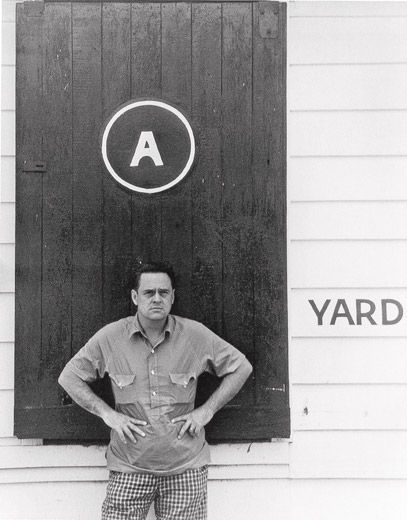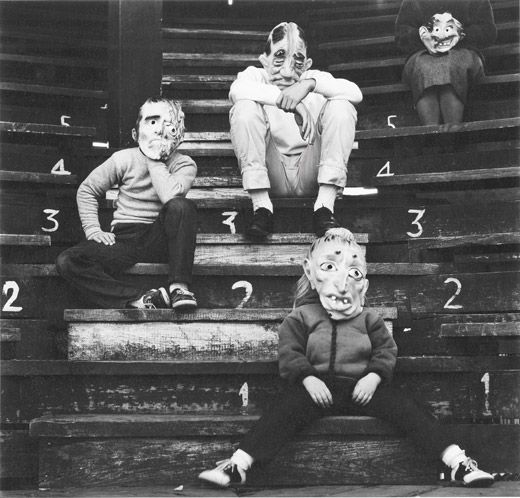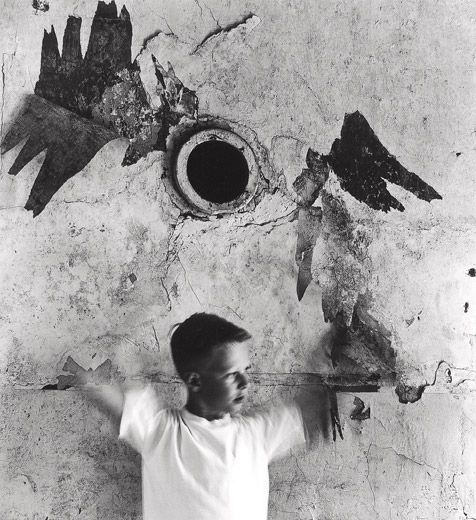Ralph Eugene Meatyard: The Man Behind the Masks
The “dedicated amateur” photographer had a strange way of getting his subjects to reveal themselves
/https://tf-cmsv2-smithsonianmag-media.s3.amazonaws.com/filer/Indelible-masks-631.jpg)
One day in 1958 or ’59, Ralph Eugene Meatyard walked into a Woolworths store in Lexington, Kentucky. An optician by trade, Meatyard was also a photographer—a “dedicated amateur,” he called himself—and he kept an eye out for props. He might drop by an antiques store to buy eerie dolls or emerge from a hobby shop with a jar of snakes or mice cured in formalin. In Woolworths, he came upon a set of masks whose features suggested a marriage of Picasso and a jack-o’-lantern.
“He immediately liked their properties,” recalls his son Christopher, who was with him at the time. Meatyard père bought a few dozen. “They were latex and had a very unique odor,” says Christopher, now 56. “In the summer they could be hot and humid.”
Over the next 13 years, Meatyard persuaded a procession of family and friends to don one of the Woolworths masks and pose in front of his camera. The resulting photographs became the best known of the pictures he left behind when he died of cancer in 1972, at age 46. That work, says the photographer Emmet Gowin, who befriended Meatyard in the 1970s, is “unlike anyone else’s in this world.”
“He picked the environment first,” Christopher says of his father’s method. “Then he’d look at the particular light in that moment in that place, and start composing scenes using the camera.” With the shot composed, he would then populate it, telling his subjects where to place themselves, which way to face, whether to move or stand still.
For the 1962 portrait on the preceding page, Meatyard chose an abandoned minor-league ballpark and arranged his wife and their three children in the bleachers. (Christopher is at left; his brother, Michael, is in the middle; his sister, Melissa, at the bottom; and their mother, Madelyn, is seated top right.) The title he gave the image—Romance (N.) From Ambrose Bierce #3—provides only the broadest hint of what he was up to: In his Devil’s Dictionary, Bierce had defined “romance” as “fiction that owes no allegiance to the God of Things as they are.”
But still, why masks? Well, “the idea of a person, a photograph, say, of a young girl with a title ‘Rose Taylor’ or the title ‘Rose’ or no title at all becomes an entirely different thing,” Meatyard once said. “ ‘Rose Taylor’ is a specific person, whether you know her nor not. ‘Rose’ is more generalized and could be one of many Roses—many people. No title, it could be anybody.” And in the same way, a mask “serves as non-personalizing a person.”
And why would someone want to do that? In an essay on Meatyard’s work, the critic James Rhem quotes one of his sitters, Mary Browning Johnson: “He said he felt like everyone was connected, and when you use the mask, you take away the differences.”
Gowin, who posed for a Meatyard portrait, recalls thinking that wearing a mask would surely erase all sense of personhood. “But when I saw the pictures,” he says, “I realized that even though you have the mask, your body language completely gives you away. It’s as if you’re completely naked, completely revealed.”
Meatyard, whose surname is of English origin, was born in Normal, Illinois, in 1925. He served stateside in the Navy during World War II and briefly studied pre-dentistry before settling on a career as an optician. He plied that trade all his working life—9 to 5 on weekdays, 9 to noon on Saturdays—but photography became his ruling passion shortly after he purchased his first camera, in 1950, to photograph his newborn son, Michael. Four years later, Meatyard joined the Lexington Camera Club. Endlessly curious, he sought inspiration in philosophy, music and books—historical fiction, poetry, short stories and collections of Zen koans. Zen and jazz were enduring influences. “How many businessmen run Buddhist-style meditation groups over the lunch hour?” asks Gowin.
Despite his self-proclaimed status as an amateur, Meatyard soon became known in serious photography circles. In 1956, his work was exhibited beside that of Ansel Adams, Aaron Siskind, Harry Callahan and Edward Weston. Five years later, Beaumont Newhall, then director of the George Eastman House, listed him in Art in America as one of the “new talents” in American photography. In the late 1960s, he collaborated with the writer Wendell Berry on The Unforeseen Wilderness, a book about Kentucky’s Red River Gorge. In 1973, the New York Times called him a “backwoods oracle.”
His last major project was The Family Album of Lucybelle Crater, a series of portraits of his wife and a rotating cast of family and friends; it was published posthumously in 1974. The project’s title was inspired by the Flannery O’Connor story “The Life You Save May Be Your Own,” in which a woman introduces both herself and her deaf-mute daughter as “Lucynell Crater.” In Meatyard’s book, everyone is masked, and everyone is identified as “Lucybelle Crater.” As Gowin says of his friend: “He was so many people all mixed up in one.”
The bookish Zen jazzmeister also served as president of the local PTA and the Little League and flipped burgers at the Fourth of July party. Meatyard “was a quiet, diffident, charming person on the surface,” says his friend the writer Guy Davenport. But that, he added, was “a known ruse of the American genius.”
David Zax, a freelance writer living in Brooklyn, New York, is a frequent contributor to Smithsonian.
/https://tf-cmsv2-smithsonianmag-media.s3.amazonaws.com/accounts/headshot/david-zax-240.jpg)



/https://tf-cmsv2-smithsonianmag-media.s3.amazonaws.com/accounts/headshot/david-zax-240.jpg)